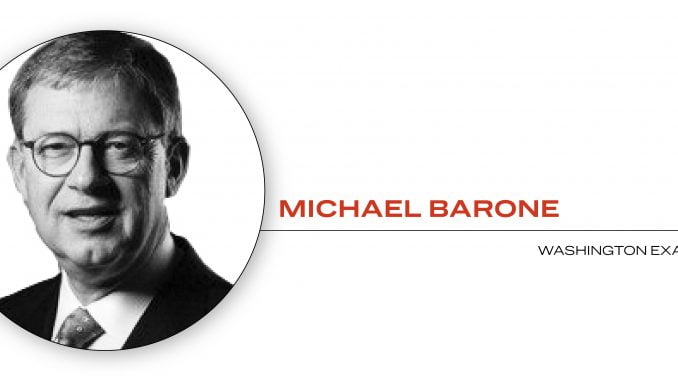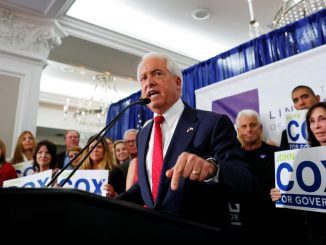
Over the last three months, political journalists have been reporting a trend toward Democrats. The Supreme Court’s reversal of Roe v. Wade, they have reported, has provided increased motivation for Democrats to turn out and vote. The easing of gas prices from their springtime peak has reduced concern about out-of-control inflation. Biden administration legislative victories have raised Democrats’ morale.
These are plausible points, validated by polling showing Republicans’ 3-4 percentage point advantage in the generic vote for the House collapsed to a dead heat in August, and also by summer polling showing Republicans trailing in every Democratic-held Senate race and in Republican seats in Pennsylvania and Wisconsin.
“Why things may really be different for this midterm election,” reads the headline of a mid-September analysis by the New York Times’ Nate Cohn. Usually, in midterm elections, the president’s party loses a few seats if his job approval is above 50% and many seats if it’s below. Structural factors are at work: The opposition party is usually better positioned to profit from local dissatisfactions. Also, it is seeking not total control but just check and balance.
Cohn, who is entitled to great respect as the author of a prescient June 2016 article showing how Donald Trump’s support from non-college graduate whites could produce victory, suggested these usual factors might not apply. But developments since he wrote, and recent history, throw his tentative conclusion into doubt.
Recent developments include polling in nine of 11 close Senate races moved toward Republicans in the month ending Sept. 22. Specifically, polls now have Sen. Ron Johnson ahead in Wisconsin, Republican challenger Adam Laxalt leading in Nevada, and Republican challenger Herschel Walker behind in Georgia by only 0.3 points in the averages.
Each trend is plausible. Johnson won in 2016 despite trailing in 29 of 30 preelection polls. Nevada has many Hispanic voters (17% of the electorate in 2020), who have been trending Republican nationally, and its relatively downscale Asian population (7%) may be headed that way as well. Sen. Raphael Warnock (D-GA) won his seat in a January 2021 runoff in which Trump’s criticism of the state’s election system depressed Republican turnout.
As for the recent history, Wisconsin is only one of many states in which polling has consistently shown Democrats running far better and Republicans far worse than they actually have when the results were counted.
A chart prepared by Andrew Prokop of Vox of 48 close (within 10 points) Senate elections from 2014 to 2020 showed eight elections in which polling understated Democratic candidates’ margins by an average of 1.8 percentage points and 40 elections in which polling understated Republicans’ margins by an average of 5 percentage points.
That trend seems to be continuing. And as Cohn notes, “Democratic Senate candidates are outrunning expectations in the same places where the polls overestimated Mr. Biden in 2020 and (Hillary) Clinton in 2016.”
“Polls have routinely underestimated the attitudes of conservative Americans over the last twenty years,” admits G. Elliott Morris, Economist polling director, in his recent book “Strength in Numbers.” “Pre-election polls,” he goes on, “face severe and prolonged threats from partisan nonresponse.”
That has gotten pollsters, as Morris notes, to massage their sampling and weighting techniques in historically unorthodox ways to try to match the actual electorate. Going far in that direction has been Republican Robert Cahaly, whose Trafalgar Research polls have shown better results for Republicans and often, but not always, numbers closer to actual results than those of other firms.
This year, many firms have been surprisingly tardy in switching from registered voter to likely voter samples, even as early voting has started in some states. As is usual, the narrower group of likely voters tends to be more Republican, as is suggested by the Republican advantage this year in primary turnout. As National Review’s Jim Geraghty points out, the current generic polls that sample likely voters show Republicans ahead by 2.8 points.
Similarly, the Sept. 18-21 ABC/Washington Post poll shows registered voters favoring Republican House candidates by an insignificant 47% to 46% margin, but likely voters favoring them by 51% to 46%. More startlingly, in congressional districts rated as competitive, registered voters favored Republicans by 55% to 34%. If that’s so, Republicans will make much greater gains than suggested by the currently tied generic vote.
Apparently, “shy Trump” voters have been refusing to be polled — an attitude possibly fortified by the denunciation by President Joe Biden in his eerily lit Independence Hall speech on Sept. 1 of “MAGA Republicans” who “represent an extremism that threatens the very foundations of the republic.”
That chilling rhetoric, together with federal non-prosecution of leftist violence against pro-life pregnancy counseling centers and Supreme Court justices’ homes, might be making many Republicans unwilling to divulge their views to pollsters affiliated with media organizations or universities. We’ll have a better idea of just how many on Nov. 9.
Michael Barone is a senior political analyst for the Washington Examiner, resident fellow at the American Enterprise Institute and longtime co-author of The Almanac of American Politics.



